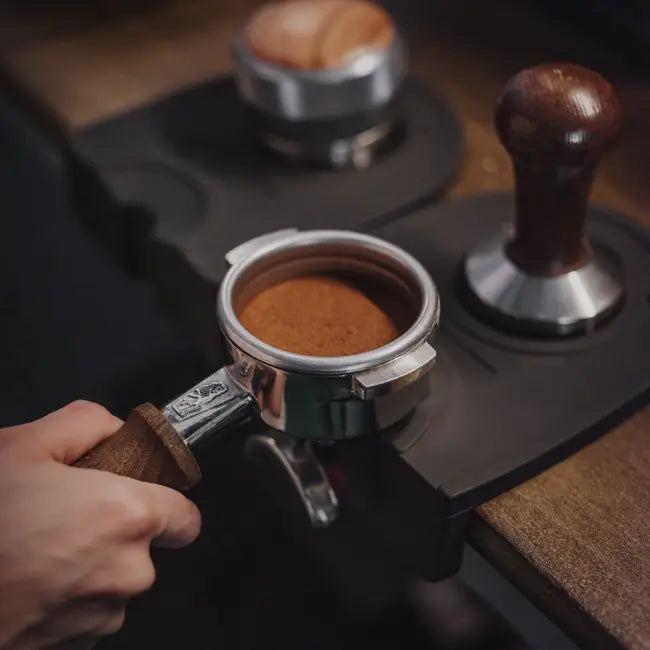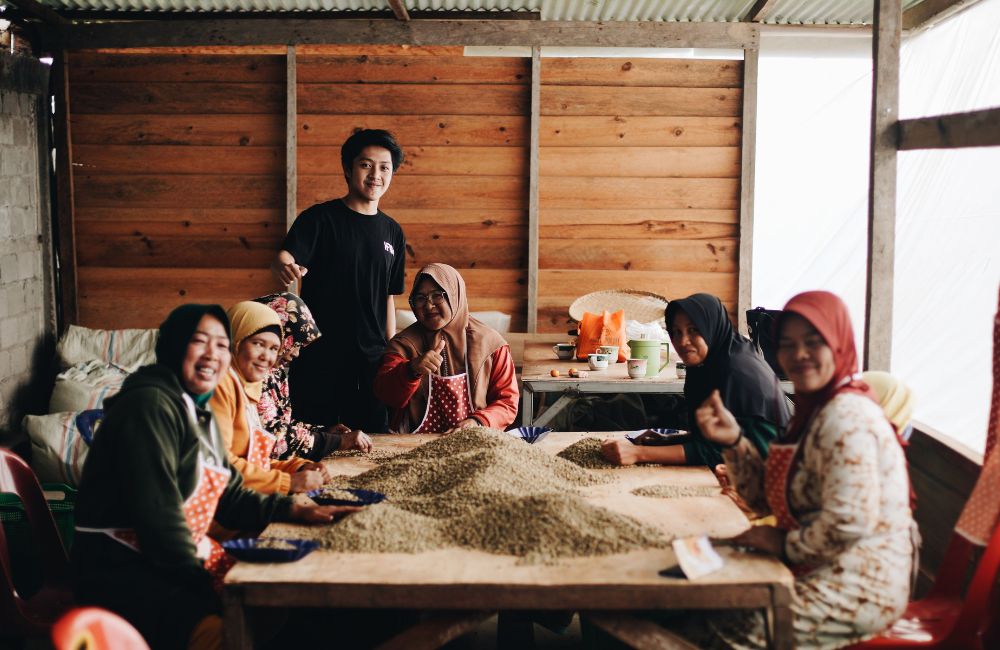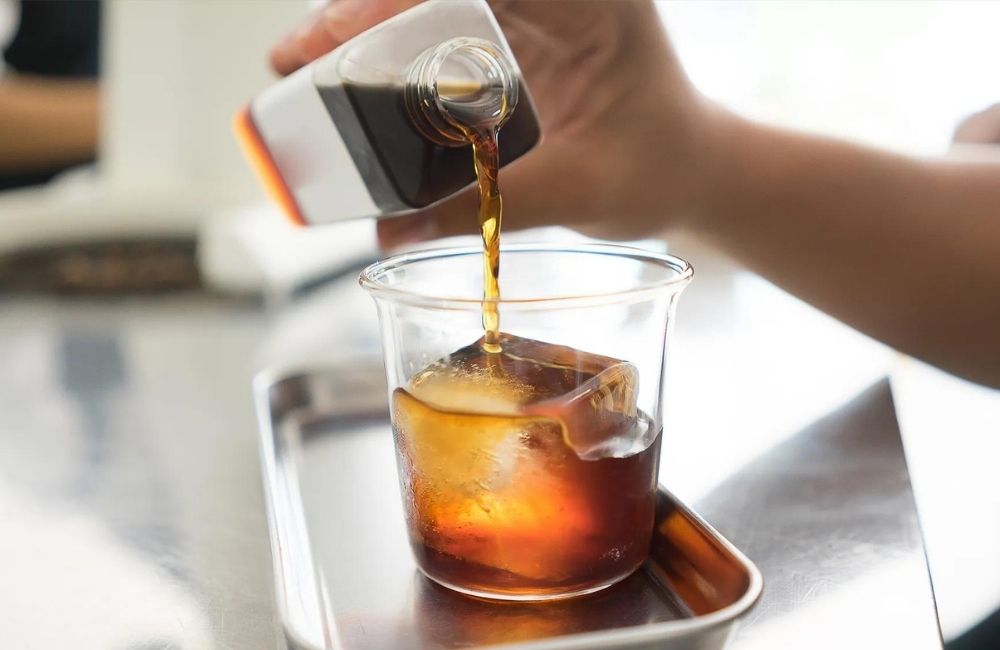Specialty Coffee: la historia de una pasión
Hace varios años, en un pequeño pueblo de Colombia, un caficultor llamado Pedro decidió desafiar a las grandes compañías que tenían el monopolio del café. Estas le compraban a él y a sus compañeros caficultores forzando precios y cuotas de producción.
Pedro decidió volver a utilizar los métodos tradiciones de cultivo que su abuelo le había enseñado, sin uso de químicos y cuidando cada cafeto con mucho amor. Sus compañeros no le entendían, así produciría mucho menos y con mucho más trabajo.
Pedro continuó a lo suyo. Además de cultivarlo, Pedro y su familia se encargaron de cosecharlo manualmente y de procesarlo con mucha atención y cuidado. Como sus compañeros habían predicho, Pedro produjo menos café que ellos y con más trabajo.
Pero Pedro tenía una idea muy clara de lo que quería: volver a saborear el primer café que su abuelo le había dado. Así que cogió un de sus sacos con granos de café y se fue a la ciudad a buscar un tostador.
Pedro encontró una cafetería con una pequeña máquina de tostar regentada por un hombre mayor. Le pidió que le dejara tostar el café y este accedió. Pedro, cansado del café quemado que se había convertido la norma -puesto que así se escondían todos los defectos- tostó su café con un tueste más ligero.
Después de tostarlo, le pidió al dueño de la cafetería que lo preparara. Cuando este le sirvió una taza y Pedro se la llevó a los labios, vio a su abuelo, delante suya, con una gran sonrisa.
El dueño de la cafetería, impresionado por la delicadeza y complejidad de este café, le compró toda la cosecha a un precio mucho mayor que el de las grandes compañías.
Esta es una historia ficticia, pero que perfectamente podría ser verdad, y que nos ilustra de forma sencilla qué es el specialty coffee.
¿Qué es el specialty coffee o café de especialidad?

Que todos los actores involucrados reciban una recompensa digna por su trabajo es parte de la filosofía del specialty coffee
El término 'specialty coffee' o 'café de especialidad' se ha convertido en la referencia para los amantes del café en todo el mundo. Pero, ¿qué es exactamente el speciality coffee y cómo se diferencia de otros tipos de café?
El specialty coffee es un término que engloba una categoría de café de alta calidad, caracterizado por su excepcional sabor, aroma y perfil sensorial. Se diferencia del café comercial por su cuidadosa selección de granos, prácticas sostenibles de cultivo, procesamiento meticuloso y tostado artesanal.
Además, en el mundo del café de especialidad, se presta especial atención a la cadena de valor, garantizando que todos los actores involucrados, desde los agricultores hasta los baristas, sean reconocidos y recompensados por su trabajo y dedicación en la producción de una bebida excepcional.
En este artículo, exploraremos el mundo del café de especialidad o specialty coffee, desde su origen hasta cómo se cultiva, procesa, tuesta y prepara, para aportarte una comprensión global.
Breve historia del café

Se dice que el café se descubrió cuando un pastor vio a su rebaño comer las cerezas
El café, una bebida apreciada y consumida en todo el mundo, tiene una historia rica y fascinante que se remonta a hace más de mil años.
Se cree que el café se originó en la región de Kaffa, en Etiopía, donde crecían de forma silvestre los cafetos Coffea arabica. Según la leyenda, un pastor etíope llamado Kaldi descubrió por casualidad los efectos energizantes de las cerezas de café cuando observó a sus cabras bailar y saltar después de consumir las cerezas rojas de los arbustos de café .
Kaldi comunicó esto a un monje, que comenzó a experimentar con estas cerezas, moliendo y mezclando las semillas con grasa animal para crear una especie de alimento energético.
A medida que el conocimiento del café se difundió a través de las rutas comerciales, llegó a la Península Arábiga en el siglo XV, donde comenzó a cultivarse y comercializarse a gran escala.
Del café comercial al Specialty Coffee
Como lo que nos interesa en este texto explorar el speciality coffee, o café de especialidad, daremos un gran salto, hasta aproximadamente 1974.
El término 'specialty coffee' fue acuñado por primera vez en estos años, 1974, por Erna Knutsen, una mujer pionera en el mundo del café que dedicó su vida a la promoción de la calidad y la sostenibilidad en la industria del café.
Erna Knutsen reconoció que algunos cafés eran de una calidad excepcional y merecían ser diferenciados de los cafés comerciales estándar. Estos eran café de un único origen, pequeños lotes que las grandes compañías no solían querer. Como el del protagonista de nuestra primera historia.
A través se su trabajo mucha gente comenzó comprender que el café es mucho más que una bebida energética y diferenciarlo del café comercial, que se caracteriza por todo lo opuesto a lo que hemos definido como specialty coffee.
La definición actual de la Specialty Coffee Association (SCA)
La Specialty Coffee Association (SCA) es una organización sin ánimo de lucro que representa a miles de profesionales del café en todo el mundo. La SCA ha establecido un sistema de puntuación para clasificar la calidad del café.
De acuerdo a la SCA un café es specialty si obtiene al menos 80 puntos en cata (sobre un total de 100). Aunque esta podría ser la definición más técnica de lo que es el specialty coffee, en realidad es mucho más que eso y la puntuación es meramente una indicación de todo el trabajo para obtenerla.
Speciality Coffee: más que una puntuación

La altitud, el clima o el terroir son algunos de los factores que contribuyen en origen a un specialty coffee
El concepto de café de especialidad ha evolucionado a lo largo de los años y ahora se refiere no solo a la calidad del grano de café, sino también a la cadena de valor completa, desde el cultivo y la cosecha hasta el procesamiento, el tostado y la preparación.
Esto significa que un café de especialidad debe cumplir con criterios específicos en cada etapa de la cadena de valor. Estos van desde el terroir, la altitud, la variedad de planta o el clima hasta los métodos de cultivo, las prácticas de procesamiento, la calidad del tostado y la habilidad del barista al preparar el café.
En todo esto es muy importante que todos los actores en la cadena de valor reciban una compensación justa por su trabajo, especialmente los productores en origen.
¿Qué determina en origen un specialty coffee?
Varios factores en origen contribuyen a la calidad de un specialty coffee, estos son:
• Localización geográfica• Clima (temperatura, humedad)• Calidad del terroir• Altitud• Variedad del coffea arabica elegida para cultivar• Conocimientos del caficultor (de plantación, cuidado y cosechado)
No existe una situación ideal standard, puesto que esta variará según la región, sino que es la unión de todos estos factores de forma positiva lo que puede dar lugar a un gran speciality coffee.
Pero en general se necesita un clima templado, con una temporada de lluvia y otra seca; es recomendable que se cultive a una elevada altitud (generalmente por encima de los 1000 metros sobre el nivel del mar) y son indispensables los conocimientos y pasión del caficultor para saber cuándo y cómo plantar y cuándo y cómo cosechar
De la cereza al grano de café de especialidad

La recogida de las cerezas en su punto óptimo de maduración es muy importante para un café de calidad
Tras el cultivo, el proceso de producción del speciality coffee comienza con la cosecha de las cerezas de café, que contienen las semillas (que luego serán los granos de café).
La cosecha debe realizarse de manera selectiva y manual para garantizar que solo se recojan las cerezas maduras y de alta calidad. Después de la cosecha, las cerezas de café se procesan mediante diversos métodos para extraer las semillas y prepararlas para el secado.
Los diferentes procesos del specialty coffee
Cuando hablamos del procesado del specialty coffee nos referimos a la forma en la que las semillas, que luego serán los granos de café, se separan de la cereza, se fermentan y se secan.
Existen varios métodos de procesamiento del café que influyen en el sabor y la calidad del producto final.
Estos métodos incluyen el lavado, el natural y el honey. Cada proceso tiene sus propias características y puede resultar en perfiles de sabor distintos en la taza .
Para poder entenderlos bien es útil tener en mente la anatomía de una cereza de café.
Anatomía de una cereza de café

Conocer la anatomía de una cereza de café nos ayuda a comprender los diferentes procesos
La cereza de café es el fruto de los cafetos. Los cafetos son la planta de café, que es una amplia familia. Para su consumo se cultivan principalmente dos variedades, el Coffea Arabica y el Coffea Robusta, aunque para el speciality coffee, se cultiva casi exclusivamente la variedad arábica.
Dentro de esta última existen muchas varietales diferentes y es decisión del caficultor cuál es la más apropiada para plantar dependiendo de las circunstancias y lo que se quiera conseguir.
De la cereza se obtienen las semillas, que luego serán los granos de café. La anatomía de una cereza de café consta de varias capas, que incluyen la piel, la pulpa, la capa de mucílago, el pergamino y la capa de plata, que rodea el grano de café en sí. El proceso de extracción de las semillas de café implica la eliminación de estas capas.
El café con proceso lavado
El proceso lavado es un método de procesamiento del café que implica la eliminación completa de la pulpa y el mucílago de las cerezas de café mediante el uso de agua y fermentación. Luego se dejan secar solo las semillas.
Este proceso da lugar a un café con un perfil de sabor más limpio y brillante, a menudo con una acidez pronunciada y una complejidad aromática.
El café proceso natural
El proceso natural es un método de procesamiento del café en el cual las cerezas de café se secan con la pulpa y la piel intactas, permitiendo que la fermentación ocurra dentro de la cereza. La cereza, pulpa y mucílago se eliminan cuando ya están secas.
Este proceso resulta en un perfil de sabor más dulce y con más cuerpo, con notas frutales y a menudo un mayor contenido de azúcares residuales.
El café con proceso honey
El proceso honey es un método de procesamiento del café que combina aspectos de los procesos lavado y natural. En este proceso, la pulpa se retira de las cerezas de café, pero se deja una cantidad variable de mucílago, lo que da lugar a diferentes grados de honey (yellow, red y black).
El perfil de sabor de un café honey puede variar desde limpio y brillante hasta dulce y afrutado, dependiendo del grado de honey y las condiciones de secado .
Métodos de fermentación del café

La fermentación es un método de procesamiento del specialty coffee
La fermentación es un método de procesamiento del café que implica la fermentación del café. Si este se produce en ausencia de oxígeno se llama fermentación anaeróbica .
Aunque toda fermentación es anaeróbica, en el mundo del specialty coffee esta se refiere a las fermentaciones que se dan en un tanque sellado y en ausencia de oxígeno.
Este proceso puede llevarse a cabo utilizando diferentes técnicas, como la maceración carbónica y la fermentación anaeróbica, entre otras. La fermentación anaeróbica puede resultar en perfiles de sabor únicos y complejos, con notas de frutas fermentadas, florales y vinosas.
Conservación, exportación y transporte del speciality coffee verde
Una vez que las semillas de café han sido procesadas y secadas, se almacenan en condiciones controladas para preservar su calidad antes de ser exportadas a los tostadores de todo el mundo.
El transporte del café verde es un aspecto crucial en la cadena de valor del café de especialidad, ya que las condiciones de almacenamiento y transporte pueden afectar significativamente la calidad y el perfil de sabor del café.
Es importante que las semillas de café se transporten en condiciones adecuadas de humedad y temperatura para mantener su calidad óptima.
El impacto del specialty coffee en los países de origen
El café de especialidad tiene un impacto positivo en los países de origen, tanto desde el punto de vista social como medioambiental.
Al centrarse en la calidad y la sostenibilidad, el café de especialidad fomenta prácticas agrícolas más respetuosas con el medio ambiente y promueve una distribución más justa de los ingresos a lo largo de la cadena de valor del café.
El enfoque en la conservación de la biodiversidad y la promoción de prácticas agrícolas orgánicas y sostenibles ayuda a proteger el ecosistema en las regiones productoras de café.
Además, una parte indispensable del concepto de specialty coffee es que los caficultores reciban un pago justo por su trabajo. Esto mejora su calidad de vida y repercute positivamente en el tejido social local.
La labor de un tostador de specialty coffee

Los tostadores son los responsables de transformar el café verde en café tostado
Los tostadores de café de especialidad desempeñan un papel clave en la cadena de valor del café, ya que son responsables de transformar el café verde en granos tostados que se utilizan para preparar la bebida.
El tostado es un proceso que requiere conocimientos técnicos y habilidades artísticas, y los tostadores de specialty coffee deben ser capaces de resaltar los perfiles de sabor únicos de cada grano.
Uno de los ejes de trabajo de los tostadores de speciality coffee es centrarse en la calidad y la trazabilidad, lo que significa que los tostadores a menudo trabajan en estrecha colaboración con los productores para garantizar la sostenibilidad y la calidad del café.
Conservación del specialty coffee tostado
Conservar el café en grano en lugar de molerlo antes de su uso es importante para preservar su frescura y calidad. El café molido se oxida y pierde sabor y aroma mucho más rápidamente que el café en grano, por lo que es aconsejable moler el café justo antes de su preparación.
Por esta razón, los tostadores deben empaquetar el speciality coffee usar bolsas cerradas de forma térmica y con una válvua unidireccional. Esto permite la expulsión de oxígeno y otros gases y retrasa la oxidación del grano.
La conservación adecuada del café en grano es crucial para mantener su calidad y frescura. El café debe almacenarse en un lugar fresco, seco y oscuro, preferiblemente en un recipiente hermético, para protegerlo de la oxidación y la degradación.
Oxidación y desgasificación del café tostado
La oxidación es un proceso químico que ocurre cuando el café entra en contacto con el oxígeno. Esto puede causar la degradación de los compuestos químicos en el café, lo que resulta en una pérdida de sabor y aroma. La oxidación es una de las principales causas de la disminución de la calidad del café que se almacena.
La desgasificación es un proceso natural en el que el café tostado libera dióxido de carbono. Este proceso es esencial para la calidad del café, ya que el dióxido de carbono puede afectar negativamente el sabor y la textura de la bebida si no se libera antes de la preparación. Esta es la razón de utilizar bolsas cerradas térmicamente y con una válvula unidireccional.
Preparación del specialty coffee

Para preparar un buen specialty coffee es necesario tener en cuenta diferentes factores
Hasta ahora hemos visto, en términos general, todo el proceso de producción del specialty coffee desde la siembra hasta que el grano está tostado y listo para que llegue a su destinatario final. Este puede ser una cafetería o un individuo particular.
Ahora expondremos de forma breve los factores que debemos tener en cuenta a la hora de preparar speciality coffee. Esto es válido tanto en el contexto de una cafetería como si lo preparas en casa, o dónde tú quieras.
Teoría de la extracción
La teoría de la extracción se refiere al proceso mediante el cual los compuestos solubles del café molido se disuelven en agua para crear la bebida final.
La extracción adecuada es crucial para lograr un sabor equilibrado y agradable en la taza, y puede verse afectada por factores como el tamaño de la molienda, la temperatura del agua y el tiempo de contacto entre el café y el agua .
Tamaño de la molienda y medida de los TDS
El tamaño de la molienda es un factor importante en la extracción del specialty coffee, ya que afecta la velocidad a la que los compuestos solubles se disuelven en agua.
Una molienda más fina aumenta la superficie de contacto entre el agua y el café, lo que puede resultar en una extracción más rápida y, potencialmente, en un sabor sobreextraído.
Por otro lado, una molienda más gruesa puede conducir a una extracción más lenta y un sabor subextraído.
Los sólidos disueltos totales (TDS) son una medida de la cantidad de compuestos solubles presentes en una bebida de café. Medir los TDS puede ayudar a determinar la calidad y la fuerza de la extracción del café, y se utiliza a menudo como una herramienta para evaluar y mejorar las técnicas de preparación.
En este contexto, cuando se habla de la distribución de la molienda nos referimos a la uniformidad del tamaño de las partículas de café molido. Una distribución uniforme es importante para lograr una extracción pareja y un sabor equilibrado en la taza.
La calidad del molinillo de café utilizado puede tener un impacto significativo en la distribución de la molienda.
Cómo moler el café

Moler el café de forma adecuada es esencial para una buena extracción
Moler el café correctamente es fundamental para lograr una extracción adecuada y un sabor equilibrado. Para moler el café, se recomienda utilizar un molinillo de calidad que proporcione una distribución uniforme y permita ajustar el tamaño de la molienda según la metodología de preparación y las preferencias personales.
Una vez que llegados a este punto, te invitamos a que repases nuestras guías de preparación de specialty coffee. En ellas encontrarás información detallada sobre cómo preparar speciality coffe con diferentes métodos, como puede ser una V60, una Aeropress o una cafetera francesa.
La cafetería de especialidad y el barista
Las cafeterías de especialidad y los baristas desempeñan un papel fundamental en la experiencia del specialty coffee, ya que son responsables de preparar y servir el café al consumidor final.
Los baristas expertos en cafeterías de especialidad deben de estar altamente capacitados y tener un profundo conocimiento de las diferentes técnicas de preparación del café, así como de los orígenes y características de cada grano.
Además, las cafeterías de especialidad a menudo actúan como espacios sociales donde las personas pueden reunirse y disfrutar de la cultura del specialty coffee.
Una labor de pasión

El specialty coffee es, ante todo, un labor de pasión por el café
A lo largo de este artículo, hemos explorado la complejidad y la profundidad del mundo del specialty coffee, desde su definición y orígenes hasta su procesamiento, conservación y preparación.
La pasión y dedicación de los productores, tostadores, baristas y consumidores en la búsqueda de la excelencia en el café de especialidad es lo que ha generado y mueve esta bonita cultura.
Al comprender los diversos factores que influyen en la calidad y el sabor del speciality coffee, podemos apreciar y disfrutar aún más de esta increíble bebida.
Si ya lo conocías en nuestra tienda online de specialty coffee encontrarás un amplia y cuidada selección de café de especialidad fresco, de temporada y recién tostado.
Y si no lo conocías ¿a qué esperas para probarlo?









